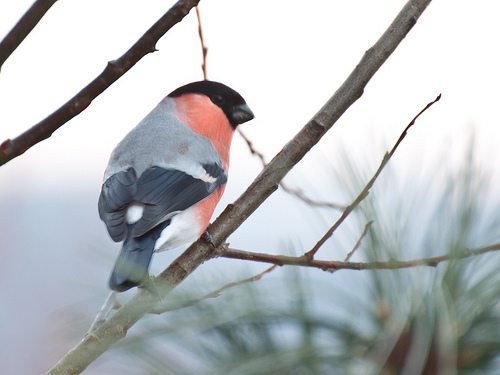We have a liberal attitude to kleptomaniac birds. We are quite happy to share the abundance of our raspberry crop with the needy families of warring blackbirds in the hedge, and don’t begrudge the bullfinches a little bit of plum blossom (mind you, they were pushing it last year.). I don’t object to them taking every reachable holly berry from our tree, because I am happy to trek a mile or so to a far more prolific bearer for my Christmas decorations. The walk is good for me. Honestly. With much of northern Perthshire currently in the grip of permafrost, it’s comforting to lurk behind festive windows and watch the resourceful birds make the most of the berries they can find in the garden. In Autumn, blackbirds and robins cheerfully hacked away at the crab apples, but these are long gone. Rowan berries last a bit longer, and if you have a pink or white berried Rowan (Sorbus hupehensis or cashmeriana are the species to look for) the birds may leave some till winter ends. If your tree is prolific, grab your own share for delicious rowan jelly to go with Christmas dinner or game; and a decent country wine can be had from them as well. Added to which, of course, a rowan tree in your garden will provide protection against evil spirits! (Turning off the TV has a similar effect). We have a Guelder Rose (Viburnum opulus) in the garden. It’s not a rose of course, but a small tree or shrub also known as Cramp-bark. You will not be surprised to hear that its bark was used to appease stomach cramps, among other things. The berries, which follow the creamy flowers, are a beautiful translucent red and are borne in such abundance, some are on the tree still, despite being raided by finches, starlings, robins and the Bankfoot United Sparrow Thugs (currently running in a gang with chaffinches and siskins it seems). If the birds can spare any, Cramp-bark berries may be used in tarts and sauces (but are indigestible to us unless cooked and sweetened), and may ward off scurvy should your Christmas diet have been short on Brussels sprouts! Between us, the birds and I have polished off the elderberries long since, but it’s a shrub I would highly recommend for wildlife if you have room. In fact I am not sure how anyone can manage without it – aside from its many household uses (dyeing, firewood, cosmetics, wood stains, charming warts and so on…..), 70 illnesses were recorded in 1666 by Martin Blockwitch in his “Anatomie of the Elder” against which this much maligned “weed” is effective! Of the more “gardeny” shrubs, Pyracanthas, Berberis and most cotoneasters will still have fruit on to feed hungry birds – and, of course, nectar for bees when the flowers come again. Which they will.
© Margaret Lear, Bankfoot. Originally published in Comment, January 2006.

